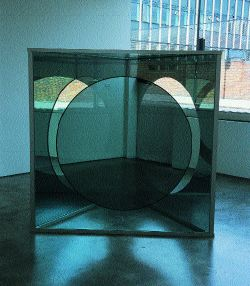Dan Graham
Lisson Gallery, London, UK
Lisson Gallery, London, UK

'Often,' remarked Dan Graham, 'there's no follow through with my work'; which, in other words, means that it stays on paper and gets by-passed by the establishment. However, Graham's recent work at the Lisson Gallery looked as if it was the target of some follow through from Roderick Buchanan's 8 iron. Buchanan did publicity shots for his new show by drilling balls at the Lisson front window (art criticism with a fat iron and a Dunlop Max-Fli?) and while the cracks in the glass were actually caused by local kids, it's hard not to feel that this is the sort of feedback Graham is craving.
Graham's work, notoriously political and questioning of art's distribution system, now faces a tougher time convincing us that it's as hard as it thinks it is. His epochal Scheme (1965) and Homes for America (1966) were magazine pieces that set new levels of text art, while Public Spaces/Two Audiences (1976) ruthlessly turned the viewing public into an exhibit. For the most part, however, Graham's pavilions have become comfy places to have a cup of tea and watch the rain, an institutional must-have, like Café Bravo at the Kunst-Werke in Berlin. And these days audience reaction tends to involve ubiquitous camcorders.
Graham began making pavilions in 1978. Since then his range of materials has become more extensive - mirrored glass, wooden screens, painted aluminium, stainless steel - but the deal is the same raw inquiry about who we are when we see the world, and how the world appears to us. The pavilions owe a lot to landscape theory, the intricate relations between sight, site and politicized sculptural sensibility. Triangular Pavilion with Circular Cut-Out Variation C (1989-2001) in the downstairs gallery evokes the historical precedent of Chinese and Japanese garden pavilions, with moon-shaped window apertures. Like Wallace Stevens' poem Anecdote of the Jar (1923), Graham's glass objects are all about paradox, about making the surrounding landscape fall into a cognitive Modernist scheme. Greek Cross Pavilion, Open Shoji Screen Version (2001) is a six-by-eight metre labyrinth structure composed of wooden shoji screens and large two-way mirror walls, a hybrid sampling of western maze and non-western opacity. Bigger than Larry Bell's contemplative glass boxes, Graham's pavilions allow viewers to get inside a Minimal object that is itself inside the gallery and the landscape. Quite often they work as other things, revolving doors, a film-viewing booth, or a café.
This show deliberately reprised the artist's long history at the Lisson (he first exhibited at the gallery in 1972 and had the inaugural show when the gallery moved in 1991). A work from the first show, Past Future Split Attention 1972 (single channel videotape performance at Lisson Gallery, March 1972), was once again exhibited here. In the video Graham can be seen in front of a seated crowd, facing a mirror and describing his, and then the audience's, reflection.
It's relatively easy to portray Graham as an artist cruising gently into the twilight of his senescence and a hip architectural milieu. His 1997 Whitney pavilion saw him juxtapose his work with that of Herzog and De Meuron and Itsuko Hasegawa. Like Vito Acconci, he has taken to designing skateboard parks, attracted to them for their unpredictability. In fact, the artist is still master of the droll stroll. 'Me and Sol LeWitt always hated that official post-War, neo-liberal humanism crap. I think Saul Bellow is disgusting', he once remarked.
But alongside Graham's own broader contextualizations of his work is the evidence of a prickly commercial interest. Drawings for the Lisa Bruce Project (1997) are Graham's foray into storefront design. Since Bruce's swimming costume designs depend on strategically placed circular cut-outs it should be a happy collaboration, but the anamorphic stretching of the mirrors transforms pilates-toned customers into lard-asses. Portal (1997), a glass portico that is also an overblown, metastasised funhouse mirror, was designed to be the entrance to a Heathrow hotel. 'It was meant to be a parody of 1980s monumentalism', says Graham, 'people don't realize that Nazi culture didn't just disappear after 1945. It became corporate culture.' Portal comes very close to answering the dangerous question posed by John Cusack in Spike Jonze's Being John Malkovich (2000): 'What happens if a man is able to enter his own portal?'
























